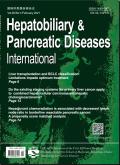Baicalin and its nanoliposome ameliorate diquat-induced liver injury by promoting PINK1/Parkin-dependent mitophagy
IF 4.4
3区 医学
Q2 GASTROENTEROLOGY & HEPATOLOGY
Hepatobiliary & Pancreatic Diseases International
Pub Date : 2025-07-01
DOI:10.1016/j.hbpd.2025.06.008
引用次数: 0
Abstract
Background
Diquat, a commonly employed bipyridyl herbicide, is recognized for its hepatotoxic effects attributed to the generation of reactive oxygen species. Baicalin (BAI), a flavonoid derivative, has garnered significant research interest for its hepatoprotective properties. Nevertheless, the clinical application of BAI is constrained by its limited water solubility and poor bioavailability. To address these challenges, BAI-nanoliposome (BAI-NL) has emerged as a novel drug delivery platform aimed at enhancing therapeutic outcomes.
Methods
We used diquat-induced liver injury mouse model and AML12 hepatocytes to test the protective effect of BAI and BAI-NL on liver inflammation, oxidative stress, and mitochondrial function. The parameters included histological, biochemical, and molecular biological analyses.
Results
In the diquat-induced model, both BAI and BAI-NL exhibited effectiveness on attenuating liver inflammation. Ex vivo analyses further indicated that BAI-NL was superior to BAI in preserving mitochondrial membrane potential, reducing oxidative stress, and modulating the phosphatase and tensin homolog-induced putative kinase 1 (PINK1)/Parkin RBR E3 ubiquitin-protein ligase (Parkin) signaling pathway. These findings enhanced mitophagy and facilitated the removal of damaged mitochondria.
Conclusions
BAI-NL exhibited superior hepatoprotective effects compared to free BAI, possibly by reducing inflammation, preserving mitochondrial homeostasis, and reinstating autophagic balance through modulation of the PINK1/Parkin signaling pathway. These outcomes indicate a groundbreaking method for addressing liver diseases and underscore the potential of nanoliposome technology in augmenting the efficacy of natural compounds.
黄芩苷及其纳米脂质体通过促进PINK1/ parkin依赖性线粒体自噬改善diquat诱导的肝损伤。
背景:Diquat是一种常用的联吡啶类除草剂,因其产生活性氧而具有肝毒性作用。黄芩苷(Baicalin, BAI)是黄酮类化合物的衍生物,因其保护肝脏的特性而受到广泛关注。然而,BAI的临床应用受到其水溶性有限和生物利用度差的限制。为了应对这些挑战,bai -纳米脂质体(BAI-NL)作为一种新的药物传递平台出现,旨在提高治疗效果。方法:采用diquat诱导肝损伤小鼠模型和AML12肝细胞,检测BAI和BAI- nl对肝脏炎症、氧化应激和线粒体功能的保护作用。参数包括组织学、生化和分子生物学分析。结果:在diquat诱导的模型中,BAI和BAI- nl均有减轻肝脏炎症的作用。体外分析进一步表明,BAI- nl在维持线粒体膜电位、降低氧化应激、调节磷酸酶和紧张素同源诱导的推定激酶1 (PINK1)/Parkin RBR E3泛素蛋白连接酶(Parkin)信号通路方面优于BAI。这些发现增强了线粒体自噬,促进了受损线粒体的去除。结论:与游离BAI相比,BAI- nl具有更好的肝脏保护作用,可能是通过调节PINK1/Parkin信号通路来减轻炎症、保持线粒体稳态和恢复自噬平衡。这些结果表明了解决肝脏疾病的突破性方法,并强调了纳米脂质体技术在增强天然化合物功效方面的潜力。
本文章由计算机程序翻译,如有差异,请以英文原文为准。
求助全文
约1分钟内获得全文
求助全文
来源期刊
CiteScore
5.40
自引率
6.10%
发文量
152
审稿时长
3.0 months
期刊介绍:
Hepatobiliary & Pancreatic Diseases International (HBPD INT) (ISSN 1499-3872 / CN 33-1391/R) a bimonthly journal published by First Affiliated Hospital, Zhejiang University School of Medicine, China. It publishes peer-reviewed original papers, reviews and editorials concerned with clinical practice and research in the fields of hepatobiliary and pancreatic diseases. Papers cover the medical, surgical, radiological, pathological, biochemical, physiological and historical aspects of the subject areas under the headings Liver, Biliary, Pancreas, Transplantation, Research, Special Reports, Editorials, Review Articles, Brief Communications, Clinical Summary, Clinical Images and Case Reports. It also deals with the basic sciences and experimental work. The journal is abstracted and indexed in SCI-E, IM/MEDLINE, EMBASE/EM, CA, Scopus, ScienceDirect, etc.

 求助内容:
求助内容: 应助结果提醒方式:
应助结果提醒方式:


